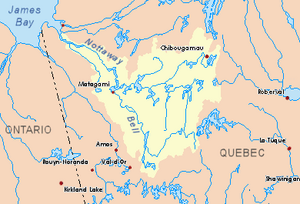Muy River facts for kids
Quick facts for kids Muy |
|
|---|---|

Watershed of Nottaway River
|
|
| Country | Canada |
| Province | Quebec |
| Region | Nord-du-Québec |
| Physical characteristics | |
| Main source | Forested creek Eeyou Istchee Baie-James (municipalité), Nord-du-Québec, Quebec 412 m (1,352 ft) 47°17′49″N 75°55′03″W / 47.29694°N 75.91750°W |
| River mouth | Wetetnagami River Eeyou Istchee Baie-James (municipalité), Nord-du-Québec, Quebec 353 m (1,158 ft) 49°10′20″N 76°04′14″W / 49.17222°N 76.07056°W |
| Length | 30.5 km (19.0 mi) |
| Basin features | |
| Tributaries |
|
The Muy River is a river in Quebec, Canada. It flows into the Wetetnagami River. This river is found in the Nord-du-Québec region, specifically in the Eeyou Istchee James Bay area.
The Muy River flows through three different areas called townships: Prévert, Muy, and Effiat.
The main activity in this area is forestry, which means cutting down trees for wood. After that, tourism and fun outdoor activities are also important.
Forest roads help people get around the Muy River Valley. Road R1015 runs north-south, and it connects to road R1051 further north. Another road, R1053, crosses the lower part of the Muy River.
Usually, the Muy River is frozen from early November until mid-May. It's safest to walk or move on the ice from mid-November to mid-April.
Contents
Where the Muy River Flows
Surrounding Rivers and Lakes
The Muy River is surrounded by many other rivers and lakes.
- To the north, you'll find the Wetetnagami River, Normandeau Lake, Nicobi Lake, Nicobi River, and Opawica River.
- To the east are the Panache River, Saint-Cyr River, Doda Lake, Corriveau Creek, and Macho River.
- To the south, there's the Macho River, Corriveau Creek, Wetetnagami River, and Saint-Père River.
- To the west, you can find the O'Sullivan River, Wetetnagami River, and Wetetnagami Lake.
Starting Point of the River
The Muy River starts from a small forest stream. This stream is located in the Prévert Township in the Eeyou Istchee Baie-James area. The starting point is about 412 meters (1,352 feet) above sea level.
From its source, the Muy River flows for about 30.5 kilometers (19 miles).
- It flows southwest for 5.2 km (3.2 mi) in the Prévert township.
- Then, it continues southwest for 16.5 km (10.3 mi) in the Muy township.
- It flows south for 2.6 km (1.6 mi) to the north shore of Muy Lake.
- It then goes south-north for 2.4 km (1.5 mi) through Muy Lake itself.
- Finally, it flows west for 3.8 km (2.4 mi) in the Effiat Township before reaching its mouth.
Journey to James Bay
The Muy River flows into the northeast shore of Wetetnagami Lake. From there, the water continues its journey.
- The Wetetnagami River flows north out of Wetetnagami Lake.
- It then empties into Nicobi Lake.
- The Nicobi River flows north from Nicobi Lake.
- It joins the Opawica River.
- The Opawica River flows north until it meets the Chibougamau River.
- This meeting point is where the Waswanipi River begins.
- The Waswanipi River flows west through Lake Waswanipi, Goéland Lake, and Olga Lake.
- It then flows into Lake Matagami.
- Finally, Lake Matagami flows into the Nottaway River, which eventually reaches Rupert Bay in James Bay.
Important Locations Nearby
The lower part of the Muy River flows through the Lake Wetetnagami Biodiversity Reserve. This is a special area protected for its natural environment.
The place where the Muy River meets Wetetnagami Lake is located:
- 15.6 km (9.7 mi) south of where the Wetetnagami River meets Nicobi Lake.
- 36.6 km (22.7 mi) south of where the Nicobi River meets the Opawica River.
- 60.6 km (37.7 mi) south of where the Opawica River meets the Chibougamau River.
- 119.3 km (74.1 mi) northeast of the town of Senneterre.
- 64.5 km (40.1 mi) northeast of the village of Lebel-sur-Quévillon.
- 101.4 km (63.0 mi) northwest of a bay on the west side of Gouin Reservoir.
Name of the River
History of the Name
Over time, different Indigenous groups have lived in this area. These include the Atikamekw, the Algonquin, and the Cree. The name "Muy" comes from a French family name.
The name "rivière Muy" (Muy River) became official on December 5, 1968. This was done by the Commission de toponymie du Québec, which is the organization responsible for naming places in Quebec.

